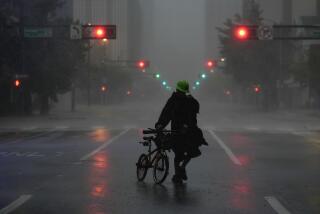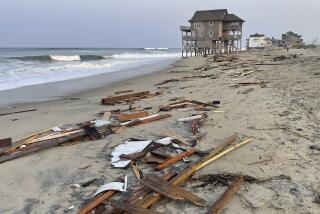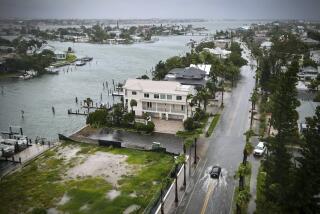Forecasters take new hurricane program for a spin
MIAMI — It stands like a sentry, on the lookout for tempests around the clock. Yet until this year, South Florida’s primary weather Doppler radar had been unable to detect the most dreaded of tropical storms: those that explode in strength just before reaching land.
Now, the bulbous installation in remote southwestern Miami-Dade County has been enhanced with a new program to better predict a storm’s intensity at the point of impact. That should spur better hurricane preparations and evacuations, officials said.
“We’re hoping that when there’s this trend of rapid intensification, this program will essentially ring a bell for us,” said Colin McAdie, a research meteorologist at the National Hurricane Center in Miami.
Called VORTRAC, for Vortex Objective Radar Tracking and Circulation, the program, in essence, is a mathematical formula. When used to sift and rearrange data furnished by the radar, it gives forecasters a close reading of the atmospheric pressure at a storm’s heart.
With that measurement supplied every six minutes -- as opposed to several hours prior to the program -- forecasters can quickly spot any strengthening or weakening.
Developed by two government agencies, the National Center for Atmospheric Research in Boulder, Colo., and the Naval Research Laboratory in Washington, D.C., the program is being field tested this year.
Had forecasters had VORTRAC in August 2004, residents of southwest Florida might have learned four to five hours sooner that Hurricane Charley was about to surge in intensity, said Wen-Chau Lee, a scientist with the National Center for Atmospheric Research.
In five hours, Charley morphed from a Category 2 to a Category 4 hurricane, its sustained winds rising from about 110 to 145 mph, before slamming into Punta Gorda and Port Charlotte. The hurricane killed nine people in Florida and left about $14 billion in damage.
Lee, who developed the concept behind VORTRAC, said forecasters used to rely on reconnaissance aircraft to calculate a storm’s central pressure. But that takes three hours or more -- based on the time a plane needs to crisscross through a storm’s eye.
In contrast, with VORTRAC, forecasters at the National Hurricane Center can “continuously monitor” a storm’s development, as long as it is within the Doppler’s 120-mile range, he said.
By itself, Doppler radar can provide the position of a storm, its structure and the intensity of its rainfall. It also can read how strong the winds are; but it cannot forecast whether a storm will strengthen as VORTRAC can, McAdie said.
Though some television stations have their own Doppler radars, those are designed to provide close-up views of local weather. All the stations tie into the government-operated Miami Doppler to augment their coverage, said Bryan Norcross, hurricane specialist for WFOR-CBS4.
Lori Vun Kannon, Broward County’s emergency management director, said knowing hours earlier whether a monster storm is in the making would allow the county to “amp up” preparatory measures, such as ordering evacuations.
“It would help us as a decision-making tool,” she said.
Jonathan Lord, assistant operations manager for the Palm Beach County Emergency Management Division, agreed.
“It will definitely improve our ability to protect the public -- which is our ultimate goal,” he said.
Intensity forecasting remains one of hurricane forecasters’ biggest blind spots, with little improvement achieved in the past three decades.
Their nightmare scenario is failing to anticipate a storm that bulks up right before landfall -- because it could catch residents by surprise.
McAdie said VORTRAC would bolster the hurricane center’s arsenal of forecasting tools in hopes of identifying the most dangerous storms earlier.
Essentially, the system takes the Doppler’s depiction of a storm’s structure and calculates the pressure at the storm’s center, based on the distance between swirls of wind.
“It’s really a lot of geometry,” said Michael Bell, another scientist at the National Center for Atmospheric Research, who worked with Lee.
Recognizable by its huge, soccer-ball-like dome, the Miami Doppler monitors an area from Stuart to the Keys. Built in the late 1980s, it is operated by the National Oceanic and Atmospheric Administration and sits on federal land southwest of Miami Metro Zoo.
It is one of seven government-operated weather radars near Florida’s coast, and one of 22 deployed along the Atlantic and Gulf coasts, all of which can now be augmented with the VORTRAC program.
Silvia Cardenes, a sales consultant for a flooring company on Southwest 137th Avenue, has a great view of the Miami radar a quarter-mile from her office. After suffering damage to her home in Hurricane Andrew in 1992 and Hurricane Wilma in 2005, she was happy to hear the radar should now be better able to warn if a dangerous storm is coming.
“Hopefully, we won’t have too many of those types of storms this year,” she said.
More to Read
Sign up for Essential California
The most important California stories and recommendations in your inbox every morning.
You may occasionally receive promotional content from the Los Angeles Times.










